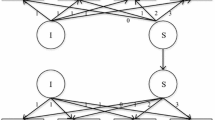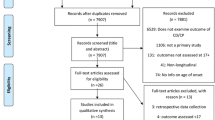Abstract
We examined the differential outcomes in residential treatment for youths with conduct disorder (CD)—with special attention paid to interactions with age and gender—in a sample of children and adolescents in 50 residential treatment centers and group homes across Illinois. Multi-disciplinary teams rated youths ages 6–20 (N = 457) on measures of mental health and other factors within 30 days of admission, about 7 months after admission, and at discharge. While both groups initially responded similarly to treatment, the CD group performed better relative to the non-CD group over the full course of treatment, showing healthier relative change on five outcomes variables and more significant improvement. Age range moderated the relationship between CD group membership and change in work/school performance. There were significant between groups differences within the youngest age group (6–11 years) in which the CD group worsened relative to the non-CD group.
Similar content being viewed by others
References
Blackman, M., Eustace, J., & Chowdhury, T. (1991). Adolescent residential treatment: A one to three year follow-up. Canadian Journal of Psychiatry, 36, 472–479.
Borduin, C. M. (1999). Multisystemic treatment of criminality and violence in adolescents. Journal of the American Academy of Child & Adolescent Psychiatry, 38, 242–249.
Brunk, M. (2000). Effective treatment of conduct disorder. Juvenile Justice Fact Sheet. Charlottesville, VA: Institute of Law, Psychiatry, & Public Policy, University of Virginia.
Burns, B. J., Hoagwood, K., & Maultsby, L. T. (1998). Improving outcomes for children and adolescents with serious emotional and behavioral disorders: Current and future directions. In M. H. Epstein, K. Kutash, & A. Duchnowski (Eds.), Outcomes for children and youth with emotional and behavioral disorders and their families: Programs and evaluation best practices (pp. 685–707). Austin, TX: PRO-ED.
Burns, B. J., Hoagwood, K., & Mrazek, P. J. (1999). Effective treatment for mental disorders in children and adolescents. Clinical Child and Family Psychology Review, 2, 199–254.
Children’s Mental Health Ontario. (2001). Children and adolescents with conduct disorder: Findings from the literature and clinical consultation in Ontario. Retrieved December 29, 2003, from http://www.cmho.org/pdf_files/CD_W3_Findings.pdf.
Connor, D. F., Melloni, R. H. Jr., & Harrison, R. J. (1998). Overt categorical aggression in referred children and adolescents. Journal of the American Academy of Child & Adolescent Psychiatry, 37, 66–73.
Crowley, T. J., Mikulich, S. K., MacDonald, M., Young, S. E., & Zerbe, G. O. (1998). Substance-dependent, conduct-disordered adolescent males: Severity of diagnosis predicts 2-year outcome. Drug and Alcohol Dependence, 49, 225–237.
Diagnostic and statistical manual of mental disorders – Text revision. (4th ed.) (2000). Washington, DC: American Psychiatric Association.
Frankfort-Howard, R., & Romm, S. (2002). Outcomes of residential treatment of antisocial youth: Development of or cessation from adult antisocial behavior. Residential Treatment for Children & Youth, 19, 53–70.
Gilliland-Mallo, D., & Judd, P. (1986). The effectiveness of residential care facilities for adolescent boys. Adolescence, 21, 311–321.
Hastings, T. L., Anderson, S. J., & Kelley, M. L. (1996). Gender differences in coping and daily stress in conduct-disorder and non-conduct-disordered adolescents. Journal of Psychopathology and Behavioral Assessment, 18, 213–226.
Henggeler, S. W., Melton, G. B., Brondino, M. J., Scherer, D. G., & Hanley, J. H. (1997a). Multisystemic therapy with violent and chronic juvenile offenders and their families: The role of treatment fidelity in successful dissemination. Journal of Consulting and Clinical Psychology, 65, 821–833.
Henggeler, S. W., Rowland, M. D., Halliday-Boykins, C., Sheidow, A. J., Ward, D. M., Randall, J., et al. (2003). One-year follow-up of multisystemic therapy as an alternative to the hospitalization of youths in psychiatric crisis. Journal of the American Academy of Child & Adolescent Psychiatry, 42, 543–551.
Henggeler, S. W., Rowland, M. D., Pickrel, S. G., Miller, S. L., Cunningham, P. B., Santos, A. B., et al. (1997b). Investigating family-based alternatives to institution-based mental health services for youth: Lessons learned from the pilot study of a randomized field trial. Journal of Clinical Child Psychology, 26, 226–233.
Henggeler, S. W., Rowland, M. D., Randall, J., Ward, D. M., Pickrel, S. G., Cunningham, P. B., et al. (1999). Home-based multisystemic therapy as an alternative to the hospitalization of youths in psychiatric crisis: Clinical outcomes. Journal of the American Academy of Child & Adolescent Psychiatry, 38, 1331–1339.
Henggeler, S. W., & Sheidow, A. J. (2003). Conduct disorder and delinquency. Journal of Marital & Family Therapy, 29, 505–522.
Hooper, S. R., Murphy, J., Devaney, A., & Hultman, T. (2000). Ecological outcomes of adolescents in a psychoeducational residential treatment facility. American Journal of Orthopsychiatry, 70, 491–500.
Institute of Medicine. (1989). Research on children and adolescents with mental, behavioral, and developmental disorders. Washington, D.C.: National Academy Press.
Joshi, P. K., & Rosenberg, L. A. (1997). Children’s behavioral response to residential treatment. Journal of Clinical Psychology, 53, 567–573.
Kazdin, A. E. (1993). Treatment of conduct disorder: Progress and directions in psychotherapy research. Development and Psychopathology, 5, 277–310.
Kazdin, A. E. (1995). Conduct disorders in childhood and adolescence (2nd ed.). Thousand Oaks, CA: Sage Publications, Inc.
Kazdin, A. E. (1997). Practitioner review: Psychosocial treatments for conduct disorder in children. Journal of Child Psychology and Psychiatry, 38, 161–178.
Kazdin, A. E., Esveldt-Dawson, K., French, N. H., & Unis, A. S. (1987). Problem-solving skills training and relationship therapy in the treatment of antisocial child behavior. Journal of Consulting and Clinical Psychology, 55, 76–85.
Lahey, B. B., Loeber, R., Burke, J., & Rathouz, P. J. (2002). Adolescent outcomes of childhood conduct disorder among clinic-referred boys: Predictors of improvement. Journal of Abnormal Child Psychology, 30, 333–348.
Larzelere, R. E., Dinges, K., Schmidt, M., Spellman, D. F., Criste, T. R., & Connell, P. (2001). Outcomes of residential treatment: A study of the adolescent clients of Girls and Boys Town. Child & Youth Care Forum, 30, 175–185.
LeCroy, C. W., & Ashford, J. B. (1992). Children’s mental health: Current findings and research directions. Social Work Research & Abstracts, 28, 13–20.
Leichtman, M., Leichtman, M. L., Barber, C. C., & Neese, D. (2001). Effectiveness of intensive short-term residential treatment with severely disturbed adolescents. American Journal of Orthopsychiatry, 71, 227–235.
Lyons, J. S., Libman-Mintzer, L. N., Kisiel, C. L., & Shallcross, H. (1998). Understanding the mental health needs of children and adolescents in residential treatment. Professional Psychology: Research and Practice, 29, 582–587.
Lyons, J. S., & Schaefer, K. (2000). Mental health and dangerousness: Characteristics and outcomes of children and adolescents in residential placements. Journal of Child and Family Studies, 9, 67–73.
Lyons, J. S., Terry, P., Martinovich, Z., Peterson, J., & Bouska, B. (2001). Outcome trajectories for adolescents in residential treatment: A statewide evaluation. Journal of Child and Family Studies, 10, 333–345.
Mann-Feder, V. R. (1996). Adolescents in therapeutic communities. Adolescence, 31, 17–28.
Moore, L. M., & O’Connor, T. W. (1991). A psychiatric residential centre for children and adolescents: A pilot study of its patients’ characteristics and improvement while resident. Child: Care, Health and Development, 17, 235–242.
Robins, L. N. (1981). Epidemiological approaches to natural history research: Antisocial disorders in children. Journal of the American Academy of Child Psychiatry, 20, 566–680.
Sholevar, P. (Ed.) (1995). Conduct disorders in children and adolescents. Washington, D.C.: American Psychiatric Press.
U.S. Surgeon General. (1999). Mental health: A report of the surgeon general. Rockville, MD: U.S. Department of Health and Human Services.
Ward, J. C., Dow, M. G., Saunders, T., Halls, S., Musante, K., Penner, K., et al. (1998). Children’s Functional Assessment Rating Scale. Odessa, FL: Psychological Assessment Resources, Inc.
Ward, J. C., Saunders, T., Dow, M., Halls, S., Musante-Mitchell, K., & Reese, R. (2003). Development of the Children’s Functional Assessment Rating Scale (CFARS) —Draft Document. Unpublished manuscript, Louis de la Parte Florida Mental Health Institute, University of South Florida, Tampa, Florida.
Werry, J. S. (1997). Severe conduct disorder: Some key issues. Canadian Journal of Psychiatry, 42, 577–583.
Acknowledgment
The authors would like to thank Elizabeth Durkin, Ph.D. for her assistance in critiquing and editing this manuscript.
Author information
Authors and Affiliations
Corresponding author
Rights and permissions
About this article
Cite this article
Shabat, J.C., Lyons, J.S. & Martinovich, Z. Exploring the Relationship Between Conduct Disorder and Residential Treatment Outcomes. J Child Fam Stud 17, 353–371 (2008). https://doi.org/10.1007/s10826-007-9146-1
Received:
Accepted:
Published:
Issue Date:
DOI: https://doi.org/10.1007/s10826-007-9146-1




